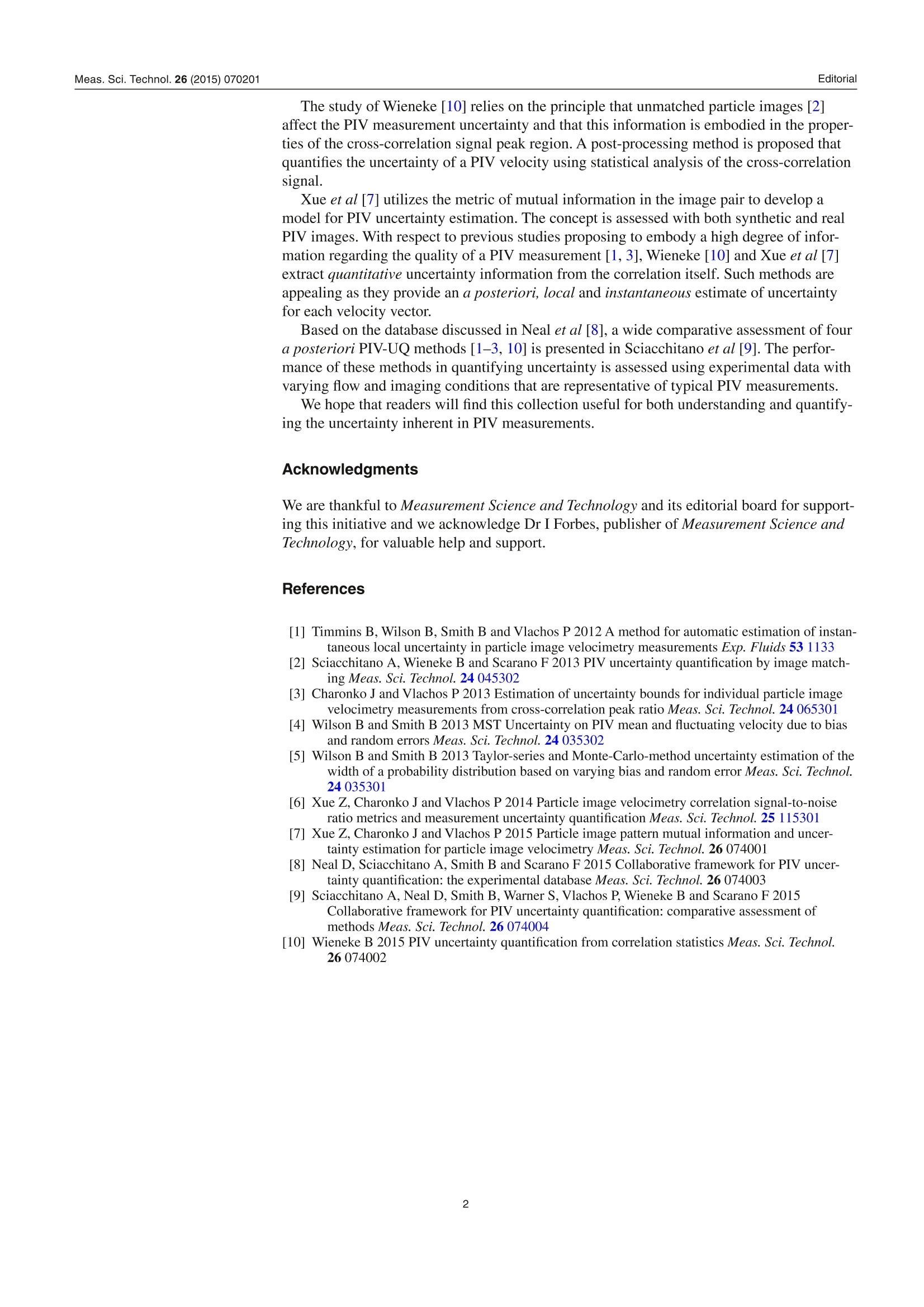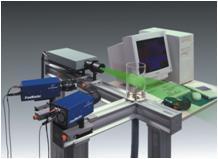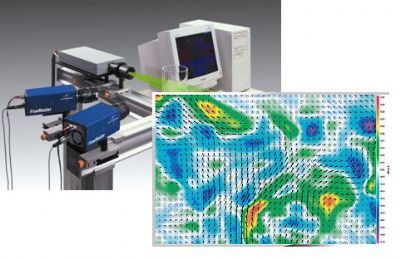方案详情
文
The latest issue of the journal Measurement Science and Technology is focusing on uncertainty quantification in Particle Image Velocimetry
The need to put an uncertainty band on a PIV vector has long been missing in the PIV community. In recent years, several methods that address this need have emerged in the literature. For this reason, Measurement Science and Technology is addressing uncertainty quantification in PIV with its recent issue. In addition to an editorial written by Prof. Kenneth T. Christensen and Prof. Fulvio Scarano, this issue contains four papers dealing with uncertainty quantification in Particle Image Velocimetry. Three of these papers are from LaVision and its research collaboration partners. These papers are (1) the introduction of the correlation statistics (CS) method, (2) the creation of an experimental database for evaluating existing PIV uncertainty methods, (3) a detailed comparison of existing PIV uncertainty methods (using this database).
Please find more information about the latest issue here.
Share this article:
方案详情

iopscience.iop.org IOP PublishingMeasurement Science and TechnologyMeas. Sci. Technol.26 (2015) 070201 (2pp)doi:10.1088/0957-0233/26/7/070201 Home Search Collections Journals AbouttContact usMy lOPscience Uncertainty quantification in particle image velocimetry This content has been downloaded from IOPscience. Please scroll down to see the full text.2015 Meas. Sci. Technol. 26 070201(http://iopscience.iop.org/0957-0233/26/7/070201) View the table of contents for this issue, or go to the journal homepage for more Download details: IP Address: 219.143.130.152 This content was downloaded on 15/07/2015 at 02:12 Please note that terms and conditions apply. Editorial CrossMark Uncertainty quantification in particle imagevelocimetrv Guest Editors KTChristensenAerospace and MechanicalEngineering Department;Civil and EnvironmentalEngineering and EarthSciences Department,University of Notre Dame,Notre Dame, IN 46556, USAE-mail: christensen.33@nd.edu F Scarano Aerospace EngineeringDepartment,Delft UniversityofTechnology, 2628 Delft,The Netherlands E-mail: fscarano@tudelft.nl The particle image velocimetry (PIV) technique for measuring fluid velocity fields in planarand volumetric domains has become a primary experimental method for the investigation ofcomplex flow phenomena in a broad range of scientifically and societally relevant applica-tions-from hypersonic flight to biomedical systems. PIV combines the view of the instan-taneous velocity pattern (in the spirit of flow visualization) with quantitative velocity data,oftentimes with sufficient temporal resolution to capture the dominant flow dynamics. Thus,PIV data is often utilized to support the development of numerical or phenomenologicalmodels of complex flow phenomena as well as for the validation of computational simula-tions of such flows. In this latter regard, the fidelity of the PIV data defines the reliabilityof the validation performed. Thus, the inherent uncertainties associated with the PIV datasets must be objectively assessed and robustly documented in order to ensure that numericalpredictions are being compared to trustworthy reference values. Those with expertise in PIV often consider it as much an art form as a science. That is,the path followed in executing a PIV experiment in a flow oftentimes will define the fidelityof the processed data. Measurement limitations imposed by the flow under study and theequipment utilized (optical access, distortions, illumination and imaging equipment, tracer-particle seeding, calibration, etc.) can define the quality of the raw data acquired (i.e. theimage pairs processed to yield an instantaneous velocity field). Subsequently, the specificprocedure followed to interrogate the acquired image pairs to yield instantaneous velocityfields (image processing, masking, correlation algorithm, peak detection, validation, etc.)also significantly influences the overall quality and reliability of the resulting PIV data. Defining general-purpose design rules to execute PIV experiments and to analyseimage pairs or sequences undoubtedly helps in alleviating some of the above challenges.Nevertheless, such rules are intimately tied to the details of the experiment being conductedFurthermore, the uncertainty in a PIV velocity field can vary significantly from experimentto experiment, and even within a given measurement owing to the spatial dependence ofmany sources of uncertainty on spatial velocity gradients, out-of-plane motion, among otherfactors. Thus, a detailed understanding of the broad range of PIV uncertainty sources thatare invariably encountered in a PIV experiment is required. The benefit of understandingand characterizing the concomitant impact of such uncertainties on post-processed PIV datais twofold. On the one hand, the PIV user will be able to make educated choices regardingoptimization of the measurement setup. Second, the uncertainties embedded in the PIV data-set will be fully quantified. To this end, Measurement Science and Technology is devoting special attention to thetopic of PIV uncertainty quantification by hosting a number of scientific articles that addressboth fundamental aspects of PIV uncertainty and their consequences [2-6]. A suite of fourrecent articles [7-10] is introduced here and complement a broader collection of past andfuture efforts published by Measurement Science and Technology on this topic, and avail-able via a dedicated web page. Neal et al [8] realized an experimental database intended to assess the ability of uncer-tainty quantification algorithms. Three simultaneous and independent measurements wereperformed in a rectangular jet using hot-wire anemometry, planar and stereoscopic PIV. Thetwo PIV systems had different dynamic velocity ranges, representing nominal measurementconditions and the corresponding reference data. A comparison of the three measurementsprovided a basis for assessing the instantaneous measurement error of the PIV data. Thedatabase is also intended as an opportunity for the PIV community to evaluate the fidelity ofexisting and future PIV processing algorithms. The study of Wieneke [10] relies on the principle that unmatched particle images [2]affect the PIV measurement uncertainty and that this information is embodied in the proper-ties of the cross-correlation signal peak region. A post-processing method is proposed thatquantifies the uncertainty of a PIV velocity using statistical analysis of the cross-correlationsignal. Xue et al [7] utilizes the metric of mutual information in the image pair to develop amodel for PIV uncertainty estimation. The concept is assessed with both synthetic and realPIV images. With respect to previous studies proposing to embody a high degree of infor-mation regarding the quality of a PIV measurement [1, 3], Wieneke [10] and Xue et al [7]extract quantitative uncertainty information from the correlation itself. Such methods areappealing as they provide an a posteriori, local and instantaneous estimate of uncertaintyfor each velocity vector. Based on the database discussed in Neal et al [8], a wide comparative assessment of foura posteriori PIV-UQ methods [1-3, 10] is presented in Sciacchitano et al [9]. The perfor-mance of these methods in quantifying uncertainty is assessed using experimental data withvarying flow and imaging conditions that are representative of typical PIV measurements. We hope that readers will find this collection useful for both understanding and quantify-ing the uncertainty inherent in PIV measurements. Acknowledgments We are thankful to Measurement Science and Technology and its editorial board for support-ing this initiative and we acknowledge Dr I Forbes, publisher of Measurement Science andTechnology, for valuable help and support. References [1] Timmins B, Wilson B, Smith B and Vlachos P 2012 A method for automatic estimation of instan-taneous local uncertainty in particle image velocimetry measurements Exp. Fluids 53 1133 [2] Sciacchitano A, Wieneke B and Scarano F 2013 PIV uncertainty quantification by image match-ing Meas. Sci. Technol. 24 045302 ( [3] Charonko J and Vlachos P 2013 Es t imation of uncertainty bounds for in d ividual particle image velocimetry measurements from cross-correlation peak ratio Meas. Sci. Technol. 24 065301 ) ( [4] Wilson B and Smith B 2013 MS T Unce r tainty on PIV mean a nd fluctuating velocity due to bias and random errors Meas.Sci. Technol. 24 035302 ) ( [5] Wilson B and Smith B 2013 Taylor-series and Monte-Carlo-method uncertainty estimation o f the width of a p robability distribution based on v arying bias a nd random error Meas. Sc i . Technol. 24035301 ) ( [6] Xue Z, Ch a ronko J a n d Vlachos P 2014 Particle image ve l ocimetry correlation signal-t o -n o iseratio metrics and m easurement un c ertainty qu a ntification Meas. Sci. Te c hnol. 25 115301 ) ( [7] Xue Z, Charonko J and Vlachos P 2015 P a rticle image pattern mutual information and uncer- t ainty estimation for particle image velocimetry Meas. Sci. Technol. 26 074001 ) ( [8] Neal D, Sciacchitano A, Smith B and Scarano F 2015 Collaborative framework for PIV uncer- tainty quantification: the experimental database Meas. Sci. T echnol. 26 074003 ) ( [9] Sciacchitano A, Neal D, Smith B, Warner S, Vlachos P, Wieneke B a nd S carano F 2015Collaborative framework fo r PIV uncertainty quantification: co m parative assessment of methods Meas. Sci. Technol. 26 074004 ) ( [10] Wieneke B 2015 PIV unc e rtainty quantification fro m correlation statistics Meas. Sci. Technol. 26 074002 ) C IOP Publishing LtdPrinted in the UK
确定



还剩1页未读,是否继续阅读?
北京欧兰科技发展有限公司为您提供《粒子成像测速PIV测量中速度矢量不确定度的定量分析检测方案(粒子图像测速)》,该方案主要用于其他中速度矢量不确定度的定量分析检测,参考标准--,《粒子成像测速PIV测量中速度矢量不确定度的定量分析检测方案(粒子图像测速)》用到的仪器有德国LaVision PIV/PLIF粒子成像测速场仪
推荐专场
相关方案
更多
该厂商其他方案
更多















